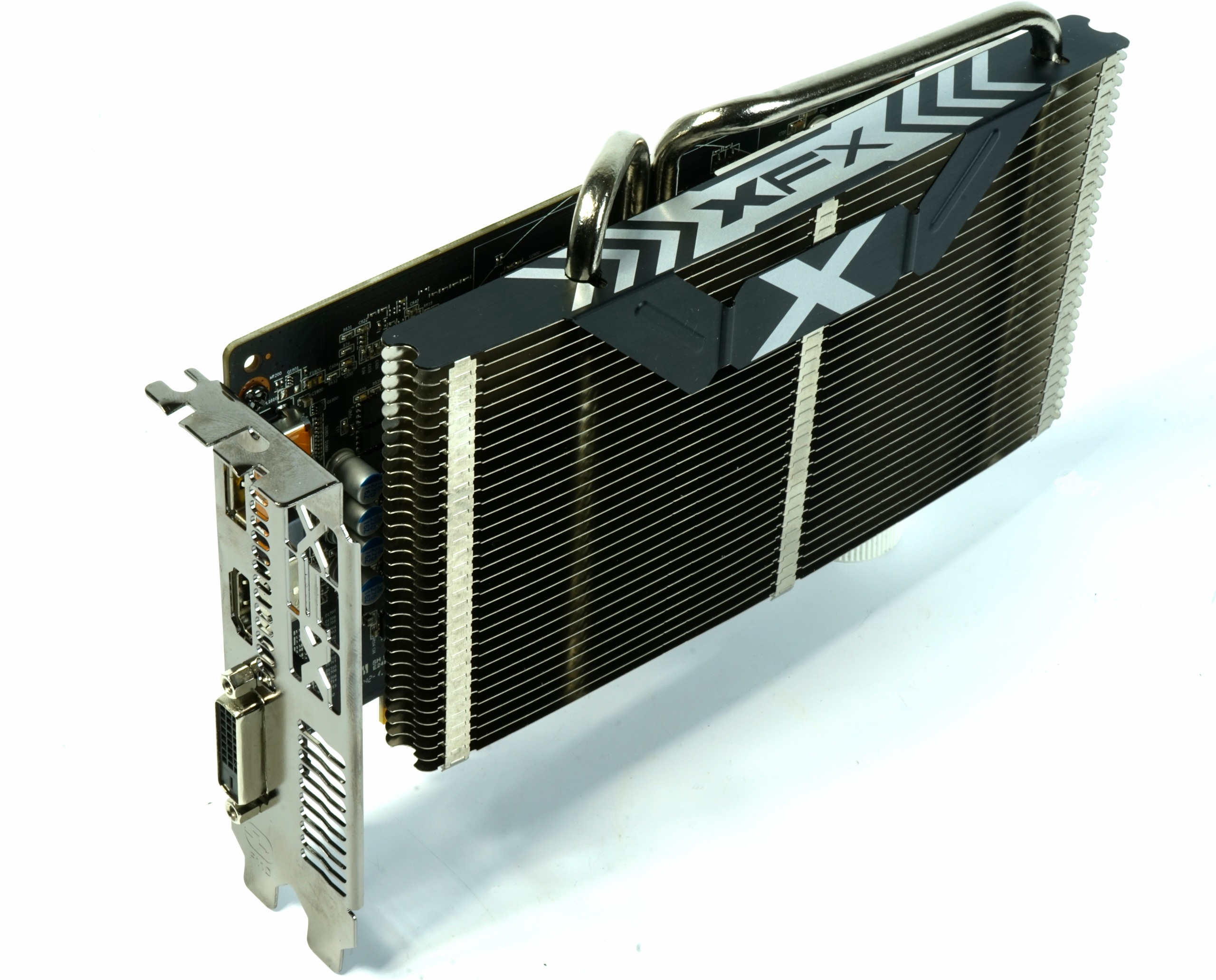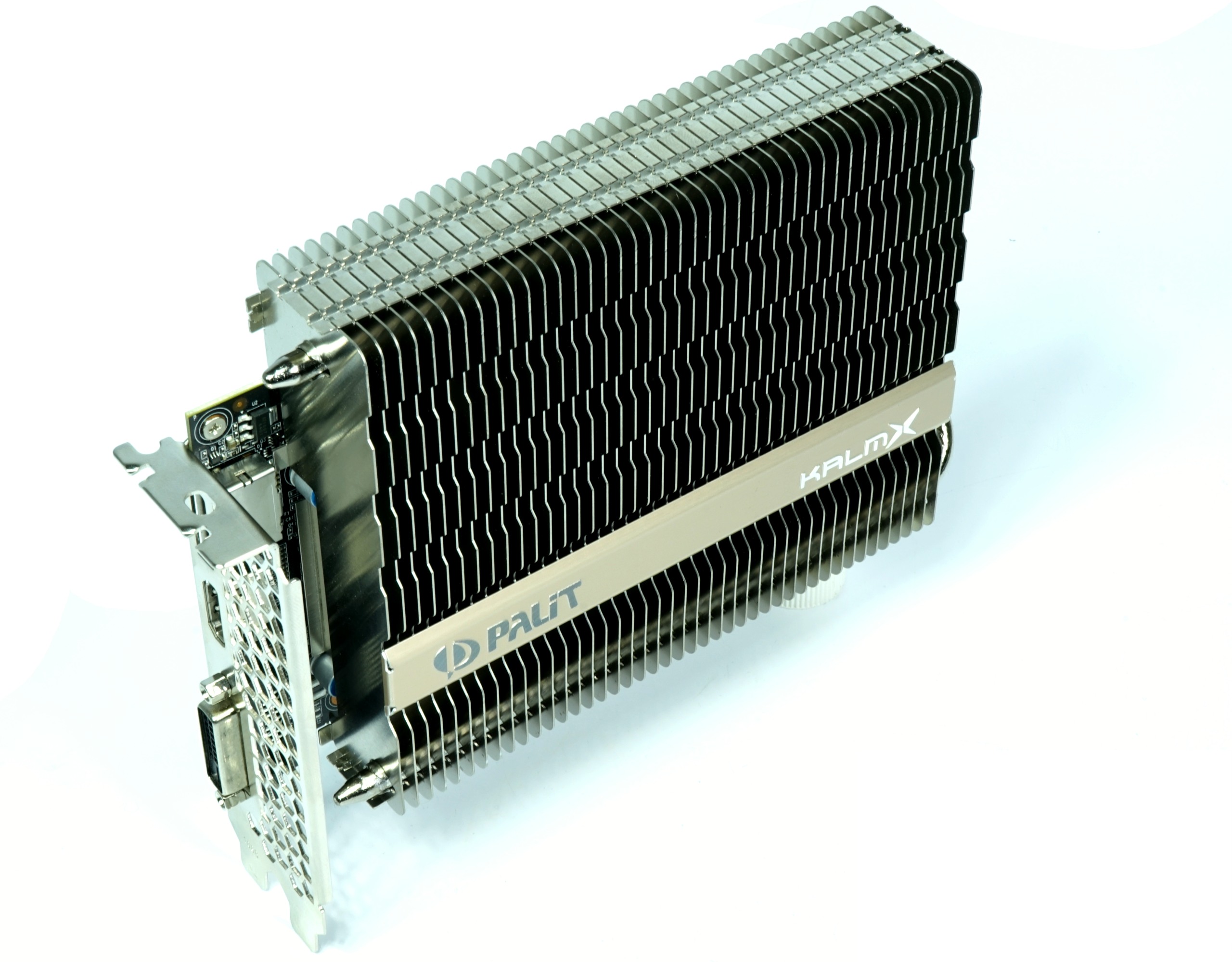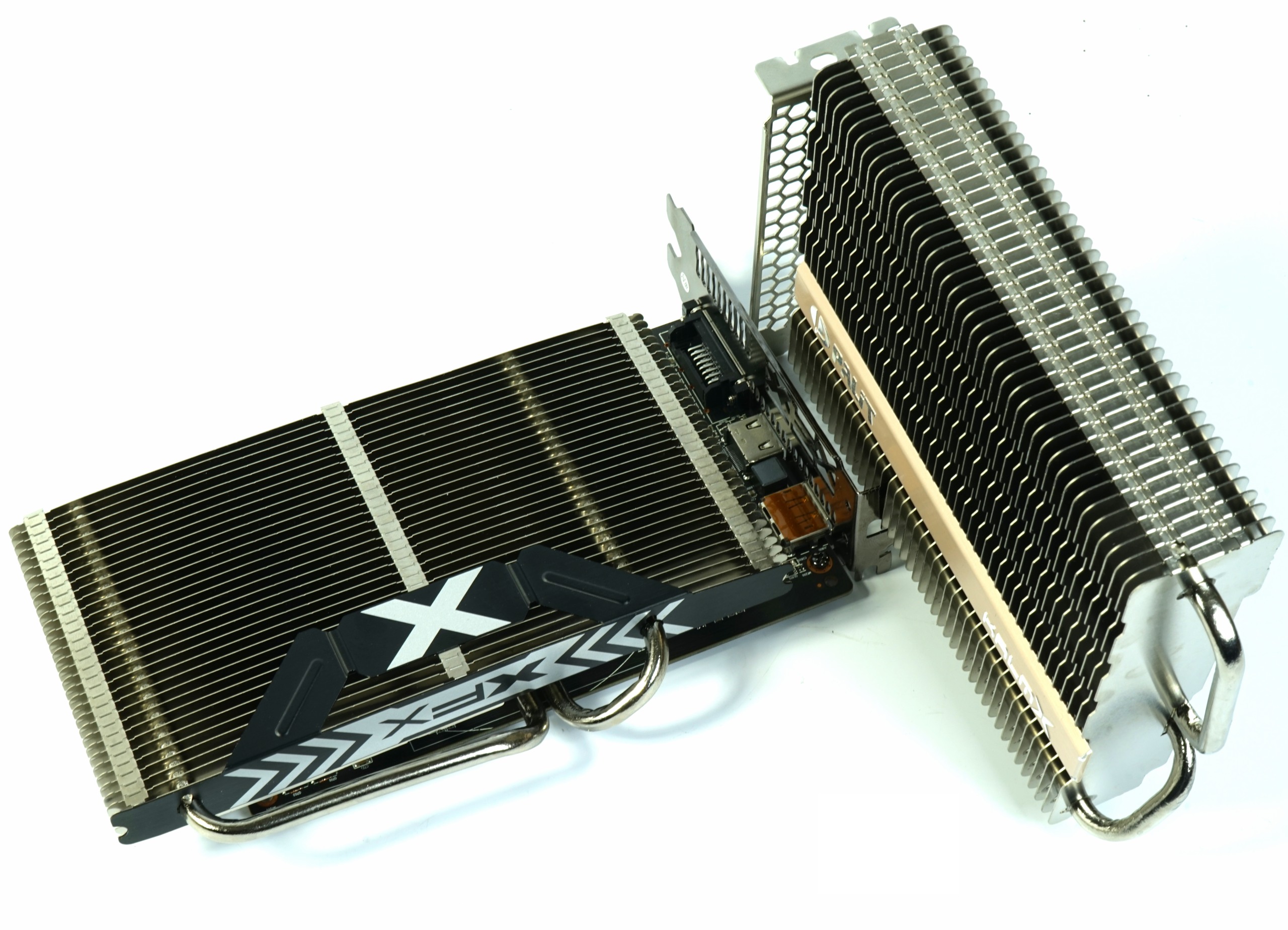Passive Cooling: XFX RX 460 Heatsink Edition Vs. Palit GTX 1050 Ti KalmX
After hacking together our own passively-cooled card, we now compare off-the-shelf solutions based on AMD and Nvidia GPUs. Was our attempt amateurish or could there be a more general problem with passively cooling current-gen graphics processors?
Summary And Conclusion
Light and shadows always go hand in hand. In the end, Palit and XFX both have skeletons in their closets here. Here's what we found:
XFX Radeon RX 460 Heatsink Edition
This card is well thought-out, but suffers because of its smallish cooler. Those horizontally-oriented fins virtually rule out self-convection.
We strongly advise XFX to use a larger cooler, which would take advantage of the full depth allowed by a wide slot bracket. A clock rate reduction to 1000 MHz might not make marketing happy, but it'd facilitate a lower voltage and allow power consumption to slide below the 50W mark.
The Radeon RX 460 Heatsink Edition isn't much more expensive than actively-cooled products based on the same GPU at least. With a bit of skill, you could even drop an ultra-quiet 92mm or 120mm fan on top of it to improve the card's behavior. That'd kind of defeat the purpose though, right?
Palit GeForce GTX 1050 Ti KalmX
Palit’s adaptation is significantly faster in our benchmarks, but it suffers from memory temperatures that climb too high. You can get actively-cooled cards that are barely audible for around $30 less, which kind of blows the point of this card away. Complicating matters for gamers in the U.S., Palit's hardware isn't readily available.
The GeForce GTX 1050 Ti KalmX would only be worth pursuing if you helped it out with a case fan. That is, if it didn't also have issues with memory temperatures, which might not even benefit from more airflow. If you like to tinker, we do know of thermal pads that'd fit. But you're better off spending less money to optimize a more readily-available card with active cooling that can be dialed down.
Conclusion
If you have at least one case fan able to push air through your enclosure, a passive card sounds like it could be a good idea. Palit's GeForce GTX 1050 Ti comes closest to making that dream a reality due to its finer-grained GPU Boost control and better heat sink.
Get Tom's Hardware's best news and in-depth reviews, straight to your inbox.
However, both cards fail to live up to their marketing. The value of these cards is lost on us until they can do what they promise.
Again, we encourage manufacturers to test and optimize their products under real-world conditions. Only then will they preemptively spot issues like insufficient cooling area or overheated memory modules.
It's only fair to recommend not purchasing either of these cards. Any decent, actively-cooled alternative easily knocks the stuffing out of either passive model, regardless of whether you prefer AMD or Nvidia. This passive experiment was a nice try, but next time use better coolers and more conservative power targets.
MORE: Best Graphics Cards
MORE: Desktop GPU Performance Hierarchy Table
MORE: All Graphics Content

Igor Wallossek wrote a wide variety of hardware articles for Tom's Hardware, with a strong focus on technical analysis and in-depth reviews. His contributions have spanned a broad spectrum of PC components, including GPUs, CPUs, workstations, and PC builds. His insightful articles provide readers with detailed knowledge to make informed decisions in the ever-evolving tech landscape
-
derekullo Watch Dogs 2Reply
1920 x 1080 Pixels
"High Settings"
FPS (Lower is better)
Made me Laugh. -
Rookie_MIB Wow. You know, they could fit a small incredibly slow fan in there somewhere that would generate zero noise and improve their results dramatically. I guess you could use the XFX in a server as the airflow scenario would allow cooling from the fans, but why would you use a GPU in a server anyhow?Reply -
Math Geek i can't think of a single scenario where this is needed. fanless gpu but you need multiple case fans to keep it cool and barely at that. why not just have the fans right on the card? double slot so you don't save any space that way, so those few cases that truly need a single slot card can't even be claimed as a market for this card.Reply
now that single slot slim fan design His showed off a while ago would be an awesome thing if it worked and was actually released.
but i just don't see this filling any need at all in a gaming pc. in a non-gaming pc a regular gpu would likely stay cool enough for the passive mode to keep the fans totally off or barely moving. yet still be able to kick it up when needed for a bit of funtime distraction. -
Pompompaihn Dumb products. If have to run system fans for them to work than what's the point of a completely fanless product? It's like saying my car gets infinite gas mileage as long as it's hooked to a tow truck...Reply -
RomeoReject Only situation where I can see them being worthwhile is in a mineral oil setup. The fan on the GPU I have in mine baaaaarely moves as is. More oil moves as a result of convection. So in that situation, it could be worth having the extra metal on there and relying on the convection effect rather than wasting that space on a fan.Reply
But that is so incredibly niche, I agree with you all: These are products searching for a purpose. -
80-watt Hamster Reply19487062 said:now that single slot slim fan design His showed off a while ago would be an awesome thing if it worked and was actually released.
Are you talking about something like this?
-
Math Geek Reply19488039 said:19487062 said:now that single slot slim fan design His showed off a while ago would be an awesome thing if it worked and was actually released.
Are you talking about something like this?
not the exact one but that's the idea. i did not know XFX had finally released it, must have missed that announcement. This article also pointed out that XFX bought HiS which i did not know. so i expect that this is the design HiS teased a while ago with XFX colors on it. this was the one they teased a while ago that seems to also have been relased http://www.hisdigital.com/gb/product2-940.shtml -
FormatC XFX bought nobody. XFX is a brand from the mother company Pine and Pine bought HIS as brand, not as single company. So are both vendors at the end only a brand from Pine and must share a lot of ressources and production lines. I saw, that they are using similar PCB layouts, only the cooling and design is a little bit different.Reply
XFX seems a real poor company. I got the card a few days for the review but I had to send it back on my own costs (because they had no more samples to rotate and no money for carriers). So it is impossible to answer on questions that requires a re-test or second look at the product. -
RomeoReject Reply
Surprised XFX has fallen so far.19491648 said:XFX bought nobody. XFX is a brand from the mother company Pine and Pine bought HIS as brand, not as single company. So are both vendors at the end only a brand from Pine and must share a lot of ressources and production lines. I saw, that they are using similar PCB layouts, only the cooling and design is a little bit different.
XFX seems a real poor company. I got the card a few days for the review but I had to send it back on my own costs (because they had no more samples to rotate and no money for carriers). So it is impossible to answer on questions that requires a re-test or second look at the product.
I know with both of my XFX R9 280X cards I had from them, they're both in great condition, and currently overclocked a wee bit (It's cold where I live). XFX also says that they'll maintain warranty despite overclocks (Below a certain power threshold) which is why I picked them in the first place.
Sad that they seem to be more dirt-baggish these days.


